story and photos by Kayte Deioma
One of the “must do” activities when visiting Guadalajara, whether it’s raining or not, is a side trip to the town of Tequila to get a glimpse at how Mexico’s national beverage is produced.
The town of Tequila is located about 37 miles west of Guadalajara. Many of the 30 or so tequila distilleries in and around Tequila offer factory tours, but the granddaddy of them all, and the one with the most tour options is the José Cuervo factory right in the center of town.
The José Cuervo distillery has created a tourist experience they call Mundo Cuervo (Cuervo World). You can access as much or as little of 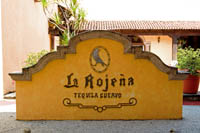 Mundo Cuervo as you have time for and fits into your budget. At the main distillery in Tequila, you can show up for a basic factory tour, which includes a tour of the distillery, La Rojeńa (named for the Cuervo son-in-law, Vincente Albino-Rojas, who acquired it as his wife’s dowry in 1812), access to the restaurant, gallery and gift shop and a margarita at the Margarita Bar. A Tasting Tour adds a sit-down tequila tasting in the Margarita Bar. A Reserva Cellar Tour adds a visit to the exclusive Reserva de la Familia (Family Reserve) aging cellar and a tasting of this premium tequila straight from the barrel under the supervision of the house tequillero. The VIP Tour is a private tour including all of the above. As of Nov 2005 prices range from 75 pesos ($7.50 US) for a basic factory tour to 250 pesos ($25 US) for a VIP Tour.
Mundo Cuervo as you have time for and fits into your budget. At the main distillery in Tequila, you can show up for a basic factory tour, which includes a tour of the distillery, La Rojeńa (named for the Cuervo son-in-law, Vincente Albino-Rojas, who acquired it as his wife’s dowry in 1812), access to the restaurant, gallery and gift shop and a margarita at the Margarita Bar. A Tasting Tour adds a sit-down tequila tasting in the Margarita Bar. A Reserva Cellar Tour adds a visit to the exclusive Reserva de la Familia (Family Reserve) aging cellar and a tasting of this premium tequila straight from the barrel under the supervision of the house tequillero. The VIP Tour is a private tour including all of the above. As of Nov 2005 prices range from 75 pesos ($7.50 US) for a basic factory tour to 250 pesos ($25 US) for a VIP Tour.
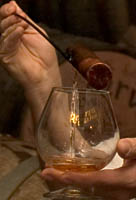 When the Spaniards colonized Mexico in the 1500s, they found the native people drinking a fermented beverage called pulque made from the heart of the maguey or agave plant. The Spaniards were running low on the spirits they had brought with them from Spain, so they distilled the pulque, creating the first mezcal wine. After a temporary ban on mezcal production in 1785, the King of Spain granted José Cuervo (Joe Crow) the first official license to produce mezcal wine in 1795. The Cuervo distillery was the first to give the name “tequila” to the type of mezcal wine produced exclusively from the heart of blue agave plants. With few exceptions, to have the designation of “tequila,” a mezcal must be produced from blue agave grown in the dry highlands of Jalisco and a few surrounding states and distilled in this same area.
When the Spaniards colonized Mexico in the 1500s, they found the native people drinking a fermented beverage called pulque made from the heart of the maguey or agave plant. The Spaniards were running low on the spirits they had brought with them from Spain, so they distilled the pulque, creating the first mezcal wine. After a temporary ban on mezcal production in 1785, the King of Spain granted José Cuervo (Joe Crow) the first official license to produce mezcal wine in 1795. The Cuervo distillery was the first to give the name “tequila” to the type of mezcal wine produced exclusively from the heart of blue agave plants. With few exceptions, to have the designation of “tequila,” a mezcal must be produced from blue agave grown in the dry highlands of Jalisco and a few surrounding states and distilled in this same area.
Mezcal (or mescal) is still the generic term for all spirits distilled from agave plants. Other mezcals are made from any of the other 136 varieties of agave, and they can be grown and distilled in other parts of Mexico. So even though tequila is a type of mezcal, all mezcals are not tequila.
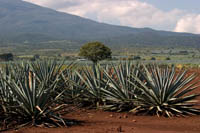 Coming from Guadalajara you drive through miles of the spiky blue-green agave, which, despite rumors to the contrary, is not a cactus. This succulent is part of the lily family which also includes its cousin, yucca. On an organized tour, your first stop is at one of these agave fields on the Cuervo plantation. If it’s wet, be sure to stick to the stone driveway or you’ll sink into the wet clay of the fields.
Coming from Guadalajara you drive through miles of the spiky blue-green agave, which, despite rumors to the contrary, is not a cactus. This succulent is part of the lily family which also includes its cousin, yucca. On an organized tour, your first stop is at one of these agave fields on the Cuervo plantation. If it’s wet, be sure to stick to the stone driveway or you’ll sink into the wet clay of the fields.
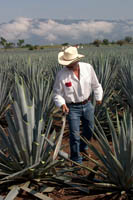 Here, we learn that an agave plant takes eight to twelve years to mature enough for harvesting and can grow to 12 or 14 feet in diameter. A jimador (agave harvester) demonstrates how the spikes are cut off the leaves of the agave with a machete to make them less sharp to work with; to force the nutrients to the heart of the agave, making it grow larger; and to prevent butterflies from nesting in the tips. The butterfly larvae or worms that are sometimes found in a bottle of mezcal, are never found in tequila. “If it is tequila” says Guillermo, our English-speaking guide, “there is no worm.” If left to grow wild, the agave would sprout a tall flower in the center, but these are also cut off to make the heart grow larger and sweeter.
Here, we learn that an agave plant takes eight to twelve years to mature enough for harvesting and can grow to 12 or 14 feet in diameter. A jimador (agave harvester) demonstrates how the spikes are cut off the leaves of the agave with a machete to make them less sharp to work with; to force the nutrients to the heart of the agave, making it grow larger; and to prevent butterflies from nesting in the tips. The butterfly larvae or worms that are sometimes found in a bottle of mezcal, are never found in tequila. “If it is tequila” says Guillermo, our English-speaking guide, “there is no worm.” If left to grow wild, the agave would sprout a tall flower in the center, but these are also cut off to make the heart grow larger and sweeter.
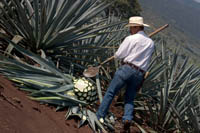 The jimador demonstrates on another plant how the agave is harvested, using a flat blade tool called a coa to cut off the leaves exposing the heart of the agave or pińa (called pineapple for its shape). The pińas usually weigh anywhere from 80 to 200 pounds. A good jimador can harvest over a ton of pińas in a day. The pińas are loaded onto trucks and taken into town to the distillery. Our jimador slices one in half and cuts off slivers for us to taste. It reminds me of jicama, a texture similar to a potato, but sweeter.
The jimador demonstrates on another plant how the agave is harvested, using a flat blade tool called a coa to cut off the leaves exposing the heart of the agave or pińa (called pineapple for its shape). The pińas usually weigh anywhere from 80 to 200 pounds. A good jimador can harvest over a ton of pińas in a day. The pińas are loaded onto trucks and taken into town to the distillery. Our jimador slices one in half and cuts off slivers for us to taste. It reminds me of jicama, a texture similar to a potato, but sweeter.
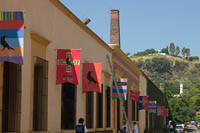 From the agave fields we continue into the town of Tequila, where the Cuervo factory, La Rojeńa, takes pride of place in the center of town, just off the plaza. The buildings of Mundo Cuervo actually fill two blocks on opposite sides of Calle José Cuervo. The Sauza Family Museum is on the other side of an adjoining wall and the National Tequila Museum is across Calle Ramon Corona. Street names change almost every block.
From the agave fields we continue into the town of Tequila, where the Cuervo factory, La Rojeńa, takes pride of place in the center of town, just off the plaza. The buildings of Mundo Cuervo actually fill two blocks on opposite sides of Calle José Cuervo. The Sauza Family Museum is on the other side of an adjoining wall and the National Tequila Museum is across Calle Ramon Corona. Street names change almost every block.
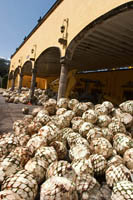 The main entrance to Mundo Cuervo is through an archway on the left side of Calle José Cuervo, across the street from Mundo Cuervo’s Cholula restaurant. The courtyard entrance to the factory is filled with a giant sculpture of a bird, representing the Cuervo crow, an oft repeated theme throughout Mundo Cuervo. Its live counterpart has pride of place in a cage in an inner courtyard. The Cuervo tour is an indoor-outdoor experience, but if it’s raining, they have enough umbrellas for everyone.
The main entrance to Mundo Cuervo is through an archway on the left side of Calle José Cuervo, across the street from Mundo Cuervo’s Cholula restaurant. The courtyard entrance to the factory is filled with a giant sculpture of a bird, representing the Cuervo crow, an oft repeated theme throughout Mundo Cuervo. Its live counterpart has pride of place in a cage in an inner courtyard. The Cuervo tour is an indoor-outdoor experience, but if it’s raining, they have enough umbrellas for everyone.
Tours begin with an orientation video in Spanish with English subtitles that introduces you to the history of Casa José Cuervo and the process of growing blue agave and turning it into fine tequilas. Then we follow our guide into the factory area where pińas are piled high waiting to be split and shoveled into room-sized steam ovens.
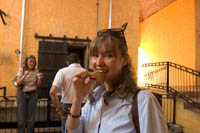 The pińas cook in the steam ovens for 36 hours to convert the starches to sugar. We get to taste a slice of the cooked agave. Although the sign says it tastes like yam, I find it much sweeter, almost like raw sugar cane, but with a tequila aftertaste.
The pińas cook in the steam ovens for 36 hours to convert the starches to sugar. We get to taste a slice of the cooked agave. Although the sign says it tastes like yam, I find it much sweeter, almost like raw sugar cane, but with a tequila aftertaste.
After cooking, the clumps of agave are allowed to cool for eight hours before being hand loaded onto conveyor belts that take them into the mill. Four mills tear up the pińas, grind them and press out the liquid. The liquid from the milled agave, called mosto or “must” is gathered in stainless steel vats where yeast is added and it ferments for about 18 hours, transforming the sugars into alcohol.
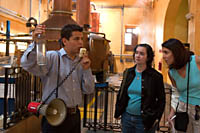 The brown fermented liquid is then distilled twice in copper stills resulting in a clear tequila that is about 55% alcohol. Since 40% is the maximum allowed, it has to be diluted with de-mineralized water to reduce the alcohol content. This fresh tequila,Tequila Blanco – also called plata or silver – is stored in stainless steel vats and bottled within 15 days.
The brown fermented liquid is then distilled twice in copper stills resulting in a clear tequila that is about 55% alcohol. Since 40% is the maximum allowed, it has to be diluted with de-mineralized water to reduce the alcohol content. This fresh tequila,Tequila Blanco – also called plata or silver – is stored in stainless steel vats and bottled within 15 days.
To mellow out the sharp taste, some of the tequila is aged in American or 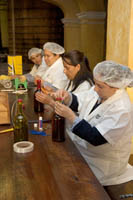 French oak barrels. Tequila aged from two months to a year is considered Tequila Reposado or rested. Aging in wood adds color as well as flavor to the tequila. Tequila aged a year or more is Tequila Ańejo. These are grades of tequila, not brands. The tour guide explains the differences between Cuervo’s various tequila brands.
French oak barrels. Tequila aged from two months to a year is considered Tequila Reposado or rested. Aging in wood adds color as well as flavor to the tequila. Tequila aged a year or more is Tequila Ańejo. These are grades of tequila, not brands. The tour guide explains the differences between Cuervo’s various tequila brands.
In the Reserva Museum, we watch a quintet of workers hand-bottling, labeling and packaging the most precious of Cuervo’s brands, Reserva de la Familia – in slow motion for our benefit. As the tour group passes, production speeds up considerably. Tourists who chose the basic or tasting tours receive a thimble full of Reserva to taste before moving on to the Margarita Bar. Those of us on the Reserva Cellar Tour continue down to the Cava or cellar, the warehouse of the original factory which is now used exclusively for aging the Ańejos three years or older used to blend each year’s Family Reserve.
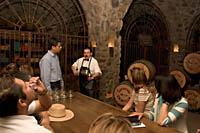 A tequillero extracts a measure of amber tequila directly from the barrel and pours it into a brandy snifter for each guest. Just like a wine tasting, we are instructed how to test the bouquet, the color and the body of the tequila before tasting it. This is definitely a sipping tequila, having many of the same properties as a good cognac or brandy.
A tequillero extracts a measure of amber tequila directly from the barrel and pours it into a brandy snifter for each guest. Just like a wine tasting, we are instructed how to test the bouquet, the color and the body of the tequila before tasting it. This is definitely a sipping tequila, having many of the same properties as a good cognac or brandy.
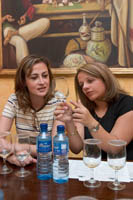 The problem with having the regular tequila testing after our visit to the Cellar is that nothing can compare with the Reserva we have just tasted. However, our palates are cleared a bit with the frozen margaritas that greet us in the courtyard of the Margarita Bar. Inside, the table is pre-set with three capped glasses of tequila at each place and a bilingual cheat sheet reviewing what to look for in a tasting. Interestingly, the three tequilas presented in the tasting are not even José Cuervo labels, they are a Blanco, a Reposado and an Ańejo that Cuervo produces under its Gran Centenario label.
The problem with having the regular tequila testing after our visit to the Cellar is that nothing can compare with the Reserva we have just tasted. However, our palates are cleared a bit with the frozen margaritas that greet us in the courtyard of the Margarita Bar. Inside, the table is pre-set with three capped glasses of tequila at each place and a bilingual cheat sheet reviewing what to look for in a tasting. Interestingly, the three tequilas presented in the tasting are not even José Cuervo labels, they are a Blanco, a Reposado and an Ańejo that Cuervo produces under its Gran Centenario label.
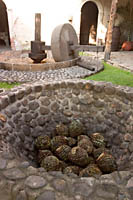 Off of the courtyard by the Margarita Bar is a gallery that wraps around to a gift shop selling fine art and hand crafts. Across the street, in an open courtyard, you can see part of the original distillery where the agave were roasted in underground pits and then milled with a grinding stone pulled by a mule. Another gift shop, where you can buy tequila and related products is in this courtyard.
Off of the courtyard by the Margarita Bar is a gallery that wraps around to a gift shop selling fine art and hand crafts. Across the street, in an open courtyard, you can see part of the original distillery where the agave were roasted in underground pits and then milled with a grinding stone pulled by a mule. Another gift shop, where you can buy tequila and related products is in this courtyard.
A little further down the street the Mundo Cuervo Museum houses exhibits of Mexican folk culture in the original hacienda. The Museum is sometimes closed for private meetings, conferences and events, so it is not always included in the tour. Public events are also held here. Mundo Cuervo has local Ballet Folklorico and pre-Hispanic dance groups and two Mariachi bands on staff. They are sometimes sent touring around the world to promote José Cuervo, but also participate in private functions at Mundo Cuervo and at local community events.
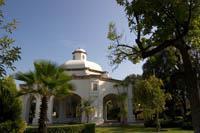 The gardens of the hacienda include a large gazebo often used for weddings and dances and a rodeo ring for charreria demonstrations. Through a fence, you can see the homestead where the family still stays when they are in town.
The gardens of the hacienda include a large gazebo often used for weddings and dances and a rodeo ring for charreria demonstrations. Through a fence, you can see the homestead where the family still stays when they are in town.
Mundo Cuervo has just added more conference and exhibition facilities on the other side of the street behind the factory. They are planning to use the stage area as a movie house for the local community when other activities are not scheduled.
Mundo Cuervo Tours are held on the hour Monday through Saturday 10 a.m. to 4 p.m., Sunday 11 a.m. to 1 p.m. I recommend calling ahead to arrange VIP tours and to make sure an English-speaking guide is available (not usually an issue, but it doesn’t hurt to make sure). Visit the web site www.mundocuervo.com or for information in Guadalajara, call (33) 3134-3368, or email: cuervo-tours@cuervo.com.mx . For information in Tequila, call (374) 742-2170 / 1168 or email:tours@cuervo.com.mx

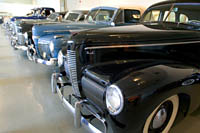 The thing that makes a museum or historical site stand out even more than the artifacts collected there are the stories that go with them and the way they are presented. Allan Unrein, Director of the Crawford Auto-Aviation Museum is a great storyteller and a man who clearly loves his work. It shows in the brief written histories identifying each vehicle in the museum’s showrooms, but having a chance to hear the stories from Unrein or the docents he trains makes a visit to the Crawford more than just a great car show.
The thing that makes a museum or historical site stand out even more than the artifacts collected there are the stories that go with them and the way they are presented. Allan Unrein, Director of the Crawford Auto-Aviation Museum is a great storyteller and a man who clearly loves his work. It shows in the brief written histories identifying each vehicle in the museum’s showrooms, but having a chance to hear the stories from Unrein or the docents he trains makes a visit to the Crawford more than just a great car show.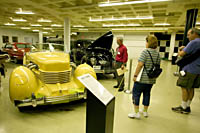 A lot of women think of car museums as a “guy thing,” all about model years and engines. At the Crawford, each car on display has a personality and personal history that makes it more than the sum of its parts. An engineer by training and many years of experience, Unrein can also tell you about the inner workings of each of the nearly 200 cars and planes in the collection. “Twenty-eight of our cars are 100 years old or older and we have 80% of our cars in working condition,” he says with pride.
A lot of women think of car museums as a “guy thing,” all about model years and engines. At the Crawford, each car on display has a personality and personal history that makes it more than the sum of its parts. An engineer by training and many years of experience, Unrein can also tell you about the inner workings of each of the nearly 200 cars and planes in the collection. “Twenty-eight of our cars are 100 years old or older and we have 80% of our cars in working condition,” he says with pride.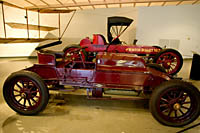 The collection leans heavily toward cars built in Cleveland between 1898 and 1931, when Cleveland was the automotive center of the nation, with 80 different car brands being built here. Among these is the first Winton ever built and two other Winton race cars. “Henry Ford applied for a job at Winton,” says Unrein, “but Alexander Winton says nah, you just don’t have it
so much for foresight.”
The collection leans heavily toward cars built in Cleveland between 1898 and 1931, when Cleveland was the automotive center of the nation, with 80 different car brands being built here. Among these is the first Winton ever built and two other Winton race cars. “Henry Ford applied for a job at Winton,” says Unrein, “but Alexander Winton says nah, you just don’t have it
so much for foresight.”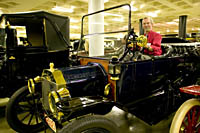 There are plenty of Fords in the collection as well, including several Model Ts, the car that put America on the road. Fifteen million of them were made between 1908 and 1928. “I can teach you everything you need to know to drive a Model T and fix it in about an hour” claims Unrein, and proceeds with some basic instruction in crank starting the car. The Crawford has one of the earliest prototypes, serial number 258 out of 15 million.
There are plenty of Fords in the collection as well, including several Model Ts, the car that put America on the road. Fifteen million of them were made between 1908 and 1928. “I can teach you everything you need to know to drive a Model T and fix it in about an hour” claims Unrein, and proceeds with some basic instruction in crank starting the car. The Crawford has one of the earliest prototypes, serial number 258 out of 15 million.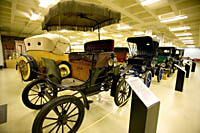 “This one is an early electric with a surrey.” He shows us a 1904 Baker. “This is an all original car, and the lady that bought it is a Baker. Baker was a car manufacturer over by where Voss is now
The lady liked it so much that she drove it back to the factory to tell Mr. Baker what a wonderful car he built. The vice president of the company came out of the building to acknowledge her and talk to her
well apparently he must have liked her, because they got married six months later.”
“This one is an early electric with a surrey.” He shows us a 1904 Baker. “This is an all original car, and the lady that bought it is a Baker. Baker was a car manufacturer over by where Voss is now
The lady liked it so much that she drove it back to the factory to tell Mr. Baker what a wonderful car he built. The vice president of the company came out of the building to acknowledge her and talk to her
well apparently he must have liked her, because they got married six months later.”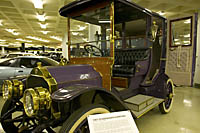 Mrs. Palmer’s 1907 Studebaker-Garford was built in Elyria, Ohio. The wife of the owner of Chicago’s Palmer House Hotel chose the heliotrope color and plush furnishings herself and liked to dress to match her car. The steering wheel is on the right, as was the custom prior to 1908. “Henry Ford was a non-conformist and he liked the left,” Unrein explains. “He made 15 million with the steering on the left, so by 1915 everybody moved to the other side.”
Mrs. Palmer’s 1907 Studebaker-Garford was built in Elyria, Ohio. The wife of the owner of Chicago’s Palmer House Hotel chose the heliotrope color and plush furnishings herself and liked to dress to match her car. The steering wheel is on the right, as was the custom prior to 1908. “Henry Ford was a non-conformist and he liked the left,” Unrein explains. “He made 15 million with the steering on the left, so by 1915 everybody moved to the other side.”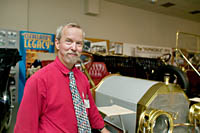 Leading the way to the back of the showroom, Unrein indicated a polished gray and beige open-top roadster with a red interior and brass fixtures. “This is a Simplex,” he says. “This is my favorite car to drive. It’s the rarest brass era pre-1915 car on the road. There are only two of these in existence and it was the fastest car that you could drive on the road in 1909. Last year at the Cleveland Air Show,” he added, “I did a simulated race against a biplane with it and it clocked at 91 miles an hour and I still had throttle left.”
Leading the way to the back of the showroom, Unrein indicated a polished gray and beige open-top roadster with a red interior and brass fixtures. “This is a Simplex,” he says. “This is my favorite car to drive. It’s the rarest brass era pre-1915 car on the road. There are only two of these in existence and it was the fastest car that you could drive on the road in 1909. Last year at the Cleveland Air Show,” he added, “I did a simulated race against a biplane with it and it clocked at 91 miles an hour and I still had throttle left.”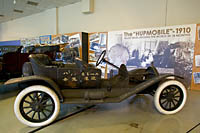 The Crawford has many rare finds and colorful car stories, but the most unusual is the 1911 “Hupmobile.” In 1910, two employees from the Hupp factory in Detroit and a Detroit Free Press Reporter took off from the factory in this ordinary car and returned 18 months, 48,600 miles and 26 countries later from a trip around a world with no road maps, gas stations or motels. They had to carry everything they needed with them. The well-worn vehicle has “world touring” painted on its sides in Chinese and Japanese characters. The factory had the car on display until 1946 and then donated it to the museum. “This summer, after minimal work, we got it running again after 92 years,” says Unrein, beaming. “I’ll bet anybody that I can give it a couple of cranks and it starts right up and runs.”
The Crawford has many rare finds and colorful car stories, but the most unusual is the 1911 “Hupmobile.” In 1910, two employees from the Hupp factory in Detroit and a Detroit Free Press Reporter took off from the factory in this ordinary car and returned 18 months, 48,600 miles and 26 countries later from a trip around a world with no road maps, gas stations or motels. They had to carry everything they needed with them. The well-worn vehicle has “world touring” painted on its sides in Chinese and Japanese characters. The factory had the car on display until 1946 and then donated it to the museum. “This summer, after minimal work, we got it running again after 92 years,” says Unrein, beaming. “I’ll bet anybody that I can give it a couple of cranks and it starts right up and runs.”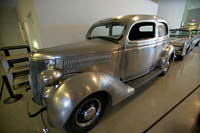 The Crawford has a striking set of three stainless steel cars, a 1936 Ford Deluxe, a 1960 Ford Thunderbird and a 1966 Lincoln Continental. “We’ve got the only matched set that’s on exhibit,” says Unrein. “The stainless steal cars were guaranteed not to rust, bust or collect dust. Those were built specifically by Ford for their supplier Allegheny Ludlum in Pennsylvania who supplied their stainless steel. Those were their salesmen’s cars. They built them at the end of the year because stainless really messes the dies up for the sheet metal, so they could only make a few of them.”
The Crawford has a striking set of three stainless steel cars, a 1936 Ford Deluxe, a 1960 Ford Thunderbird and a 1966 Lincoln Continental. “We’ve got the only matched set that’s on exhibit,” says Unrein. “The stainless steal cars were guaranteed not to rust, bust or collect dust. Those were built specifically by Ford for their supplier Allegheny Ludlum in Pennsylvania who supplied their stainless steel. Those were their salesmen’s cars. They built them at the end of the year because stainless really messes the dies up for the sheet metal, so they could only make a few of them.”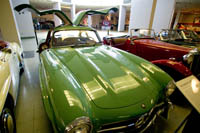 Some other more modern items in the collection include a 1946 Volkswagen – one of only two brought into the country that year; a 1949 Bentley – one of only five built that year with left hand steering; a 1956 Mercedes-Benz SL300 with “gull wing” lift-up doors; Kenny King’s 1958 Chrysler 300 – “which will outrun anything they have today”; a 1966 American Motors AMX prototype; and the first DeLorean ever produced (1981) – serial number 1. The Museum also recently acquired a 50s Ford Anglia similar to the one featured in the Harry Potter movies. Only a portion of the collection will fit in the two floors of display area. The rest is in a preservation facility at 30 th Street and Chester, which can be visited only by special appointment.
Some other more modern items in the collection include a 1946 Volkswagen – one of only two brought into the country that year; a 1949 Bentley – one of only five built that year with left hand steering; a 1956 Mercedes-Benz SL300 with “gull wing” lift-up doors; Kenny King’s 1958 Chrysler 300 – “which will outrun anything they have today”; a 1966 American Motors AMX prototype; and the first DeLorean ever produced (1981) – serial number 1. The Museum also recently acquired a 50s Ford Anglia similar to the one featured in the Harry Potter movies. Only a portion of the collection will fit in the two floors of display area. The rest is in a preservation facility at 30 th Street and Chester, which can be visited only by special appointment.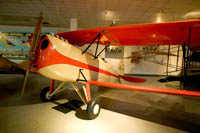 The aviation portion of the collection is much smaller. Only four of the Crawford’s dozen or so aircraft are on display in the museum, including a replica of the Wright brothers’ original glider; a 1929 Great Lakes 2T-1A Sport Trainer; a 1910 Curtiss Model E Bumblebee “hydroaeroplane”; and a 1944 North American P-51K-NT-10 Mustang Second Fiddle. Most of the others are currently undergoing restoration.
The aviation portion of the collection is much smaller. Only four of the Crawford’s dozen or so aircraft are on display in the museum, including a replica of the Wright brothers’ original glider; a 1929 Great Lakes 2T-1A Sport Trainer; a 1910 Curtiss Model E Bumblebee “hydroaeroplane”; and a 1944 North American P-51K-NT-10 Mustang Second Fiddle. Most of the others are currently undergoing restoration.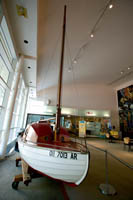 As its one piece of aquatics history, the Museum has the original “Tinkerbelle” on display. Robert Manry hand-crafted the small sailboat and in 1965 successfully sailed it from Falmouth, Massachusetts to Falmouth, England. The original craft in which he spent 78 days and nights is on view upstairs with some other related memorabilia. A replica is displayed downstairs where children can take a closer look.
As its one piece of aquatics history, the Museum has the original “Tinkerbelle” on display. Robert Manry hand-crafted the small sailboat and in 1965 successfully sailed it from Falmouth, Massachusetts to Falmouth, England. The original craft in which he spent 78 days and nights is on view upstairs with some other related memorabilia. A replica is displayed downstairs where children can take a closer look.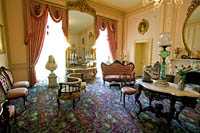 early 1960s, Crawford arranged to donate the collection to the Western Reserve Historical Society (WRHS). A new building was added at their Cleveland headquarters to house the new Crawford Auto-Aviation Museum, a new Archives Library and Gift Shop. The Library’s Automotive Marque Files include pamphlets, user’s manuals and schematics for many of the cars in the collection and others.
early 1960s, Crawford arranged to donate the collection to the Western Reserve Historical Society (WRHS). A new building was added at their Cleveland headquarters to house the new Crawford Auto-Aviation Museum, a new Archives Library and Gift Shop. The Library’s Automotive Marque Files include pamphlets, user’s manuals and schematics for many of the cars in the collection and others.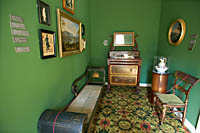 The WRHS Library is the largest archive of information and artifacts on Northeast Ohio history and includes extensive genealogical information. Adjacent to the Crawford Museum, the WRHS operates the Hay House, a mansion built in 1911, and the Chisolm Halle Costume Wing with rotating special exhibits.
The WRHS Library is the largest archive of information and artifacts on Northeast Ohio history and includes extensive genealogical information. Adjacent to the Crawford Museum, the WRHS operates the Hay House, a mansion built in 1911, and the Chisolm Halle Costume Wing with rotating special exhibits.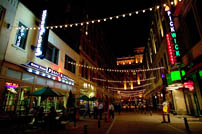 It wasn’t raining, but we had another good rainy night destination in mind. We were headed for Pickwick & Frolic, an original Cleveland venue where we would find dinner, a comedy club and martini bar all under one roof – even on a Tuesday night. Located just a couple blocks from our hotel on East 4th Street, Pickwick & Frolic occupies the bottom two floors of the former Kresge Building, which was built on the foundations of the old Euclid Avenue Opera House. As a historic renovation, many of the buildings original features have been maintained. One of the few remaining historic streetscapes downtown, this block of East Fourth Street is also home to the recently opened Cleveland House of Blues.
It wasn’t raining, but we had another good rainy night destination in mind. We were headed for Pickwick & Frolic, an original Cleveland venue where we would find dinner, a comedy club and martini bar all under one roof – even on a Tuesday night. Located just a couple blocks from our hotel on East 4th Street, Pickwick & Frolic occupies the bottom two floors of the former Kresge Building, which was built on the foundations of the old Euclid Avenue Opera House. As a historic renovation, many of the buildings original features have been maintained. One of the few remaining historic streetscapes downtown, this block of East Fourth Street is also home to the recently opened Cleveland House of Blues.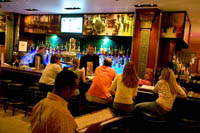 Pickwick and Frolic is four different venues in one. You enter into the Dickens-inspired Pickwick Restaurant, where “rustic American cuisine” is prepared in an open kitchen and a bar runs along the left side of the room. Around the other side of the bar, another dining area overlooks the Frolic Cabaret, where an all-women revue performs “Cabaret Rock” Thursday through Saturday. A stairway at the end of the open kitchen leads down toward the back of the building to Hilarities 4 th Street Comedy Club, which can seat over 400 with tiered tables, booths and skyboxes. Another ornamental curved stairway leads from the restaurant down to the cabaret area and to the adjacent red and white nouveau-deco Kevin’s Martini Bar.
Pickwick and Frolic is four different venues in one. You enter into the Dickens-inspired Pickwick Restaurant, where “rustic American cuisine” is prepared in an open kitchen and a bar runs along the left side of the room. Around the other side of the bar, another dining area overlooks the Frolic Cabaret, where an all-women revue performs “Cabaret Rock” Thursday through Saturday. A stairway at the end of the open kitchen leads down toward the back of the building to Hilarities 4 th Street Comedy Club, which can seat over 400 with tiered tables, booths and skyboxes. Another ornamental curved stairway leads from the restaurant down to the cabaret area and to the adjacent red and white nouveau-deco Kevin’s Martini Bar.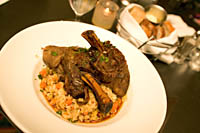 Since it wasn’t a Cabaret evening, we dined in the restaurant. On the appetizer menu (prices from $2.50 to $10.95), I was tempted by the Wood Grilled Portabello Mushroom Cap Stuffed with Roasted Peppers, Goat Cheese, Eggplant & Roasted Pine Nuts, with Sweet Onion Dressing, but knowing that I never have room for an appetizer AND an entrée and I have no place to keep the leftovers, I decided to stick with just an entrée. Carol agreed. She chose the Pan Seared Sea Scallops with Butternut Coulis, Roasted Tomato-Spinach Ragout and Risotto. It was extremely difficult to choose from so many delectable-sounding oven-fired and wood-grilled selections (prices $12.95 to $28.95), but I finally opted for the Roasted Lamb Shank w ith Roasted Root Vegetable Risotto.
Since it wasn’t a Cabaret evening, we dined in the restaurant. On the appetizer menu (prices from $2.50 to $10.95), I was tempted by the Wood Grilled Portabello Mushroom Cap Stuffed with Roasted Peppers, Goat Cheese, Eggplant & Roasted Pine Nuts, with Sweet Onion Dressing, but knowing that I never have room for an appetizer AND an entrée and I have no place to keep the leftovers, I decided to stick with just an entrée. Carol agreed. She chose the Pan Seared Sea Scallops with Butternut Coulis, Roasted Tomato-Spinach Ragout and Risotto. It was extremely difficult to choose from so many delectable-sounding oven-fired and wood-grilled selections (prices $12.95 to $28.95), but I finally opted for the Roasted Lamb Shank w ith Roasted Root Vegetable Risotto.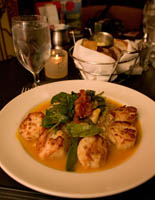 This may not be the place to go if you’re counting calories. Most menu items are quite rich and portions are generous. My dinner came with two thick lamb shanks beautifully seasoned and nicely presented on a bed of risotto. But I have to admit that Carol’s sea scallops, which she generously let me try, were even better. The tender scallops were nicely seared and cooked to melt-in-you-mouth perfection. The blend of roasted tomatoes, spinach and squash was a heavenly complement to the shellfish.
This may not be the place to go if you’re counting calories. Most menu items are quite rich and portions are generous. My dinner came with two thick lamb shanks beautifully seasoned and nicely presented on a bed of risotto. But I have to admit that Carol’s sea scallops, which she generously let me try, were even better. The tender scallops were nicely seared and cooked to melt-in-you-mouth perfection. The blend of roasted tomatoes, spinach and squash was a heavenly complement to the shellfish.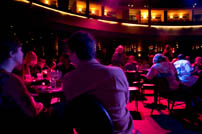 On this Tuesday night, since it was a smaller crowd, only the area immediately around the stage was open for seating, giving the club a very intimate, café feel, despite the size of the room. Many of the patrons who had skipped the restaurant and come straight to Hilarities were enjoying drinks and bar snacks from the bar menu. Servers continued to circulate throughout the performance. This was not one of the regularly scheduled smoke-free shows (Wednesdays at 8, Fridays at 7:30), but either smoking was at a minimum or the special air filtration system that was airlifted onto the roof of the building to keep clean air circulating was working really well, which I appreciated.
On this Tuesday night, since it was a smaller crowd, only the area immediately around the stage was open for seating, giving the club a very intimate, café feel, despite the size of the room. Many of the patrons who had skipped the restaurant and come straight to Hilarities were enjoying drinks and bar snacks from the bar menu. Servers continued to circulate throughout the performance. This was not one of the regularly scheduled smoke-free shows (Wednesdays at 8, Fridays at 7:30), but either smoking was at a minimum or the special air filtration system that was airlifted onto the roof of the building to keep clean air circulating was working really well, which I appreciated.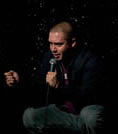
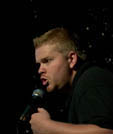

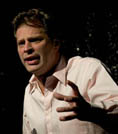 The lineup included host, Chris Hegedus, popular Cleveland area comic John Wellington and Lamar Williams from Rochester, New York, who recently returned from entertaining the troops in Iraq. Headliner, Tommy Blaze, formerly of the 1994-95 comedy sketch series, The Newz, kept us rolling in the aisles with his take on gender differences and the challenges of single parenting. His Spiderman interpretation was also quite striking.
The lineup included host, Chris Hegedus, popular Cleveland area comic John Wellington and Lamar Williams from Rochester, New York, who recently returned from entertaining the troops in Iraq. Headliner, Tommy Blaze, formerly of the 1994-95 comedy sketch series, The Newz, kept us rolling in the aisles with his take on gender differences and the challenges of single parenting. His Spiderman interpretation was also quite striking.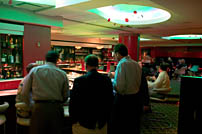 After the 90-minute show, Kevin’s Martini Bar is open late for your choice of high-end cocktails. It was reasonably well-populated for a Tuesday night, but since the expectant mama wasn’t drinking, we decided to head back to the hotel.
After the 90-minute show, Kevin’s Martini Bar is open late for your choice of high-end cocktails. It was reasonably well-populated for a Tuesday night, but since the expectant mama wasn’t drinking, we decided to head back to the hotel.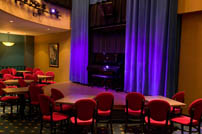 Pickwick & Frolic offers Dinner and a Show specials Thursday through Saturday that include a buffet dinner prepared by the Pickwick kitchen, the Frolic Cabaret show “Cabaret Rocks” and the Hilarities comedy show for a flat rate. Prices range from $34.95 to $41.95 per person depending on the day. The Dinner and a Show buffet can be arranged on other nights for groups of 20 or more. For business travelers, Pickwick and Frolic offers a wide array of meeting, catering and entertainment options.
Pickwick & Frolic offers Dinner and a Show specials Thursday through Saturday that include a buffet dinner prepared by the Pickwick kitchen, the Frolic Cabaret show “Cabaret Rocks” and the Hilarities comedy show for a flat rate. Prices range from $34.95 to $41.95 per person depending on the day. The Dinner and a Show buffet can be arranged on other nights for groups of 20 or more. For business travelers, Pickwick and Frolic offers a wide array of meeting, catering and entertainment options.